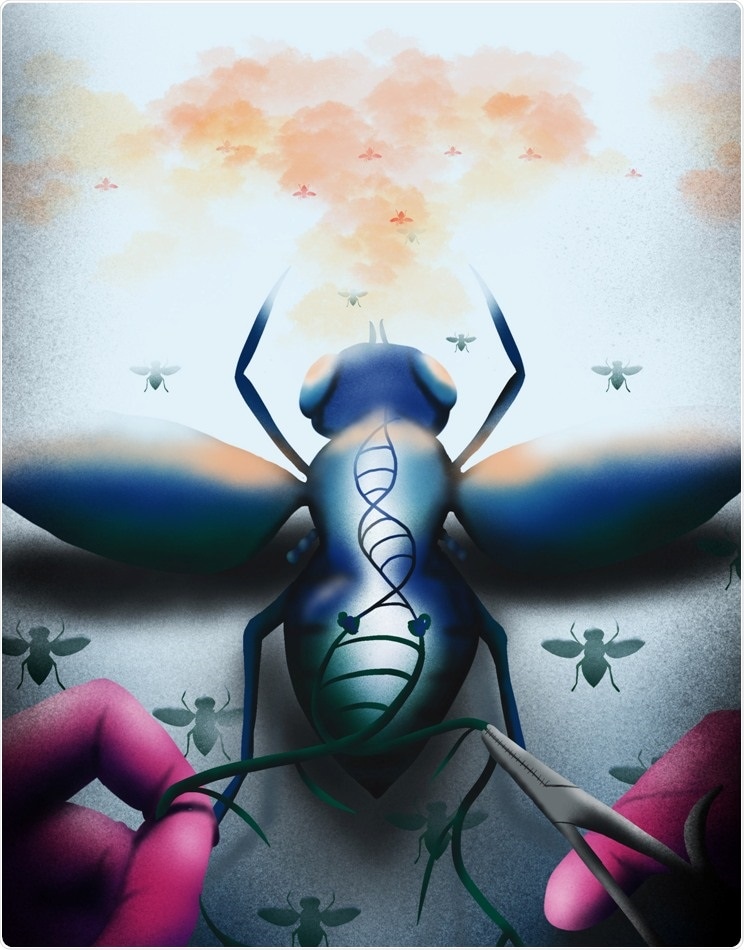In the last 10 years, scientists have designed a range of novel tools that regulate the balance of genetic inheritance.

Active genetic systems: UC San Diego scientists and their colleagues have developed two new genetic systems that halt or eliminate gene drives after release. Image Credit: Ana Silva.
These gene drives, which are based on the CRISPR technology, are set to move from laboratory settings into the wild, where they are being designed to inhibit devastating diseases, like mosquito-borne malaria, chikungunya, dengue, yellow fever, Zika, and West Nile.
Gene drives have the power to immunize mosquitoes against malarial parasites, or serve as genetic insecticides that decrease the populations of mosquitos.
Even though the latest gene drives have been shown to spread efficiently as engineered in laboratory settings, there have been concerns about the safety of discharging these systems into wild populations. Questions have also emerged regarding the controllability and predictability of gene drives and whether, once let loose, they can be recalled in the field if they spread other than their intended application area.
A team of researchers from the University of California San Diego and their collaborators have now devised two novel active genetic systems that deal with these kinds of risks by eliminating or stopping the gene drives in the wild. On September 18th, 2020 in the Molecular Cell journal, a study headed by Xiang-Ru Xu, Emily Bulger, and Valentino Gantz in the Division of Biological Sciences provides two novel solutions based on elements designed in the common fruit fly.
One way to mitigate the perceived risks of gene drives is to develop approaches to halt their spread or to delete them if necessary. There’s been a lot of concern that there are so many unknowns associated with gene drives. Now we have saturated the possibilities, both at the genetic and molecular levels, and developed mitigating elements.”
Ethan Bier, Study Senior Author and Distinguished Professor, University of California, San Diego
Bier is also the science director for the Tata Institute for Genetics and Society.
The initial neutralizing system, known as e-CHACR (erasing Constructs Hitchhiking on the Autocatalytic Chain Reaction), has been developed to prevent the spread of a gene drive by “shooting it with its own gun.”
e-CHACRs employ the CRISPR enzyme Cas9 carried on a gene drive to copy itself and, at the same time, mutates and inactivates the Cas9 gene. An e-CHACR can be situated anywhere in the genome, stated Xu.
Without a source of Cas9, it is inherited like any other normal gene. However, once an e-CHACR confronts a gene drive, it inactivates the gene drive in its tracks and continues to spread across several generations ‘chasing down’ the drive element until its function is lost from the population.”
Xiang-Ru Xu, Study Lead, University of California, San Diego
The second neutralizing system, known as ERACR or Element Reversing the Autocatalytic Chain Reaction, has been developed to remove the gene drive completely. ERACRs are developed such that they can be introduced at the location of the gene drive, where they utilize the Cas9 from the gene drive to attack either side of the Cas9 gene, cutting it out. As soon as the gene drive gets deleted, the ERACR copies itself and substitutes the gene-drive.
Bier added, “If the ERACR is also given an edge by carrying a functional copy of a gene that is disrupted by the gene drive, then it races across the finish line, completely eliminating the gene drive with unflinching resolve.”
The team rigorously and meticulously tested and examined both ERACRs and e-CHACRs and also the resulting DNA sequences at the molecular level.
According to Bier, the researchers including the mathematical modelers from UC Berkeley spent around a total of 15 years of effort to expansively develop and examine the novel systems. Yet, Bier cautioned that there are unexpected circumstances that could rise, and the neutralizing systems should not be utilized with a false sense of security for gene drives that can be implemented on the field.
Bier further added, “Such braking elements should just be developed and kept in reserve in case they are needed since it is not known whether some of the rare exceptional interactions between these elements and the gene drives they are designed to corral might have unintended activities.”
According to Bulger, gene drives have huge potential to ease suffering, but their responsible deployment depends on having regulated mechanisms in place in case unexpected consequences arise. eCHACRs and ERACRs offer new ways to halt the gene drive from spreading and, in the case of the ERACR, can possibly revert an engineered DNA sequence to a state that is relatively closer to the naturally-occurring sequence.
Because ERACRs and e-CHACRs do not possess their own source of Cas9, they will only spread as far as the gene drive itself and will not edit the wild type population. These technologies are not perfect, but we now have a much more comprehensive understanding of why and how unintended outcomes influence their function and we believe they have the potential to be powerful gene drive control mechanisms should the need arise.”
Emily Bulger, Study Lead, University of California, San Diego
Source:
Journal reference:
Xu, X-R. S., et al. (2020) Active Genetic Neutralizing Elements for Halting or Deleting Gene Drives. Molecular Cell. doi.org/10.1016/j.molcel.2020.09.003.